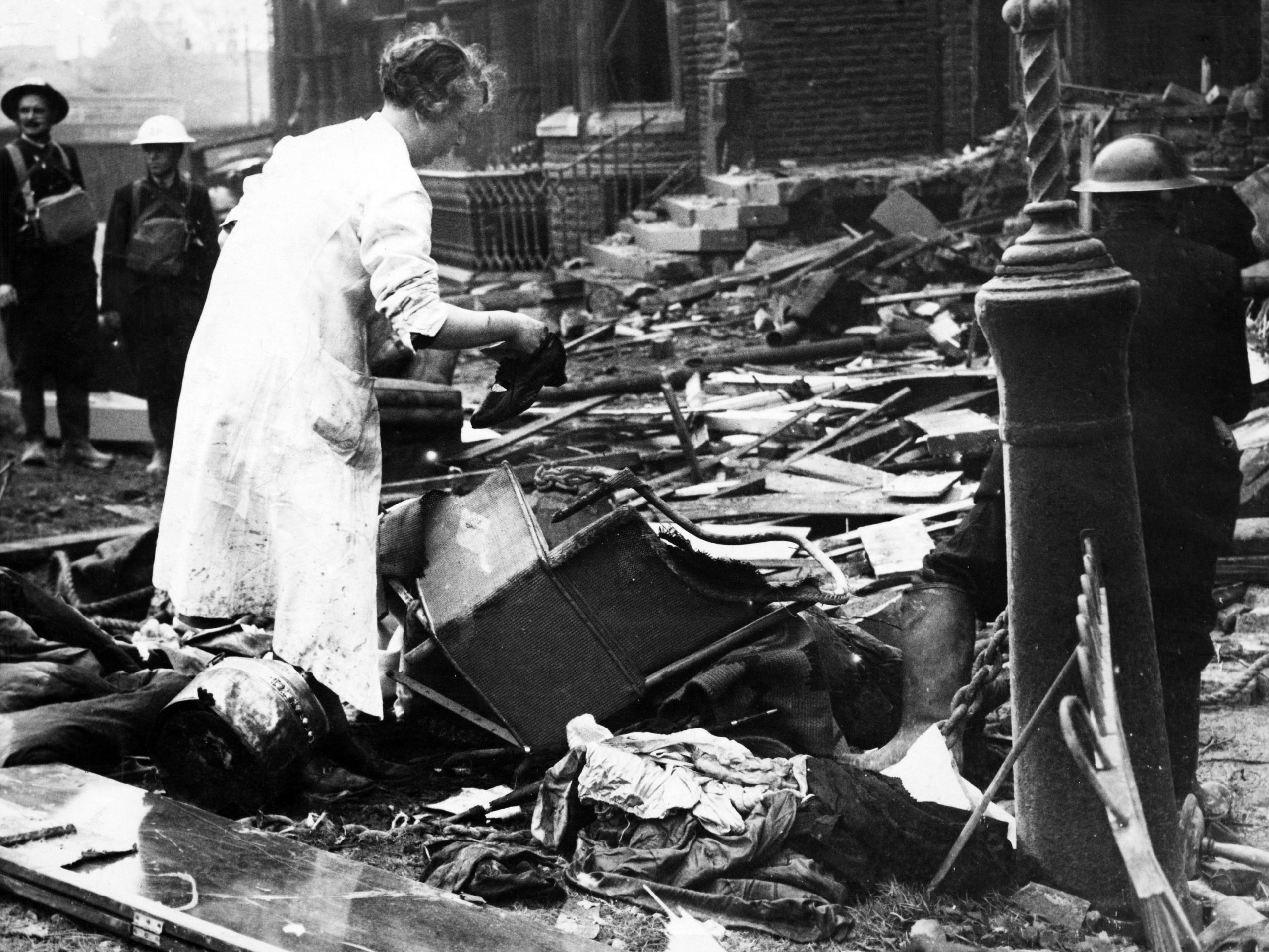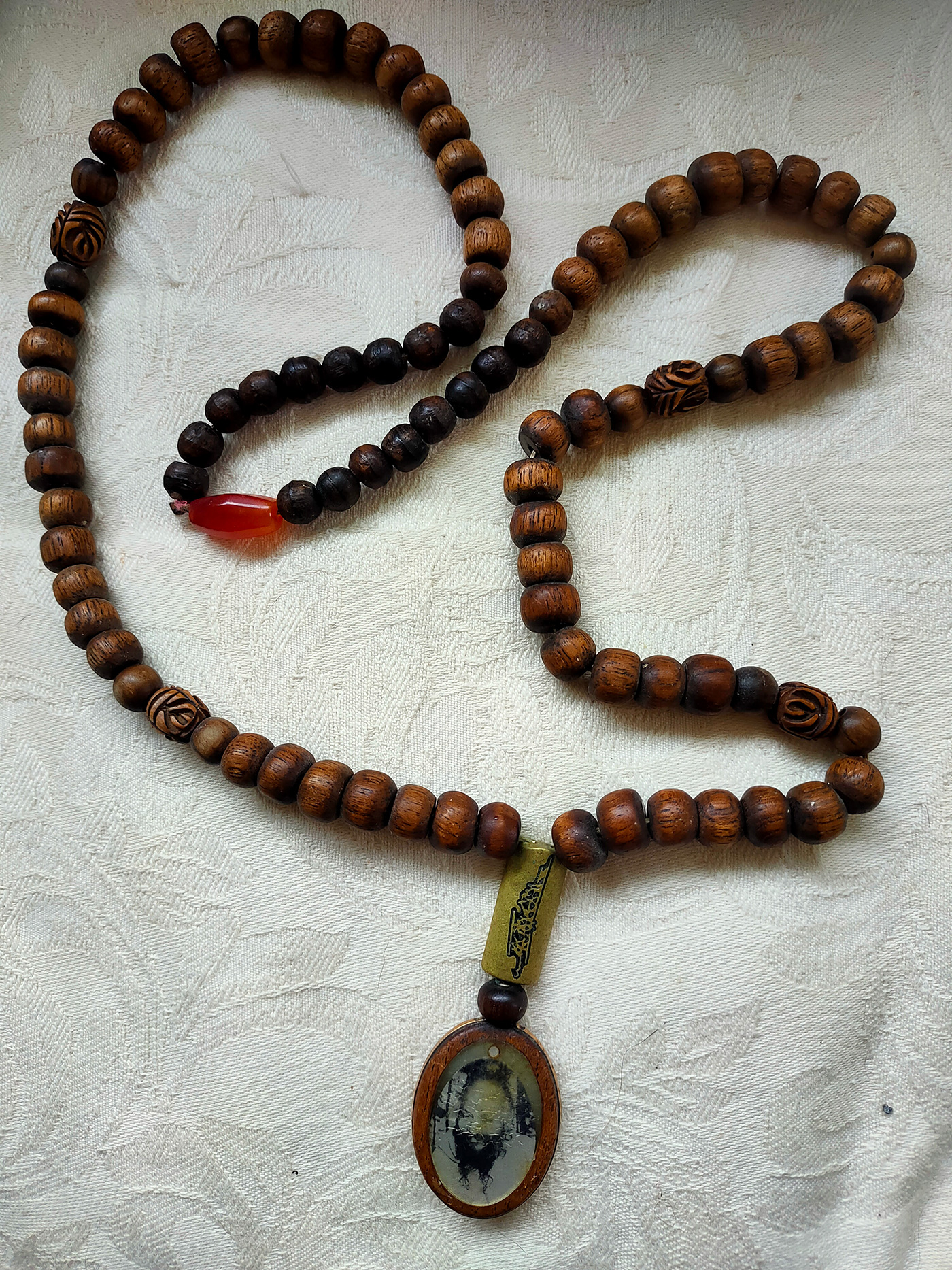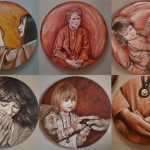Christo’s love for wood and woodworking brought him to create the first ashram-made mala

Liverpool
Carpentry workshops everywhere hold the unique exotic aroma of the sap and bark of distant forests, combined with the musical pitch and rhythm of cutters, planes and hammers – creating one of the most joyful and friendly work environments, in my opinion. I fell in love with woodworking while in Liverpool in the 1960s and early ’70s, when I started working with a bunch of guys in an abandoned warehouse at Wapping Docks. We called it Open Design, and made custom-built furniture. I never did learn, like Dave, one of our members, to do perfect dovetail joints, but on the whole it was a wonderful creative time.
We shared the premises with a militant left-wing newspaper editor, Derek, who in his upstairs office spent his time organising demos on behalf of striking dockworkers, ex-Prisoner Relief or other worthy causes. The staircase was piled with ‘Say NO’ and ‘Kill the Pigs’ placards. You could always tell when there was a dock strike on – a line of men would be standing outside the pub with their copy of the Daily Mirror at 8am as we arrived for work, waiting for opening time at 10, probably tossed out of the house by their wives… and Derek would be on overdrive. In quieter times he was a genial, cordial neighbour.
Life in Liverpool was hard for a long time after the war. The docks had been badly damaged in successive Luftwaffe bombardments and there was no money left to rebuild.
However, for us the demolition of the docks and surrounding area presented a great opportunity, a magical wonderland of row upon row of abandoned, bombed-out terraced houses full of priceless Honduras mahogany or teak floorboards and staircases, a rarity in contemporary timber markets. It was possible to salvage and work with some of the most beautiful woods for free, and collect old tools, hardware, locks and fittings like seashells scattered on the beach.
I met many remarkable characters during my time in Liverpool, the more so as I myself was coming from the kind of regimented, suburban background where every weekday morning at 7am, as if on cue, front doors opened and streams of men in dark suits and bowler hats, carrying furled umbrellas, rushed out to catch the early London train.
I am so grateful that, despite family pressure, I managed, not without difficulty, to escape this fate.
One of the most remarkable people I remember at the Docks at this time was an elderly blind ‘chippee’ who worked in one of the smaller mills where we used to take wood for planing and cutting. A huge unshielded bandsaw, constantly in use, snaked its way across the whole floor area, the ultimate hazard, one would have thought, for a blind worker. However, what particularly impressed us all about Les was that he could put the palm of his hand on any plank of wood and tell you exactly the tree of origin. It was impossible to catch him out and, moreover, he could tell how well it had been seasoned – essential information for door or cabinet frames.
Another friend, Mike, was a skilled wood-turner who made, among other things, the most beautiful decorative hairpins from wooden offcuts. He had his own shop and workshop on the same premises. I loved to visit from time to time and watch him work – a true artist.
After my first year in Pune I returned briefly to the UK and spent a week in Liverpool visiting old friends. I wasn’t prepared for the shock I got when I saw Mike again. Behind the desk of his workshop was this barely-recognisable bloated figure with a pallid swollen face like a cream bun. Gone were all the hairpins and other artefacts of his trade, replaced with empty and half-empty wine and cider bottles. Mike spent the time boasting how he now got booze with his welfare money. I left deeply shocked and sad. I later learned his wife had up and left him…
I had on many occasions seen how the local culture discouraged men from discussing problems or sharing feelings. The standard response to any emotional problem big or small was to ‘go for a bevy’ (i.e. the pub). I was grateful to be able, in the short time I was back there, to get a small group together to do Dynamic Meditation – which I later learned continued and flourished after I left.
One of my final memories before I left Liverpool is of a small girl about 11 years old who used to stand in the middle of the road continually whirling around and repeating over and over again the first two lines of the song ‘Where’s your Mama gone?’ in a broad Scouse accent. I often wondered what happened to her.

Pune
I first arrived in Pune in December 1974. Osho called me ‘Christo the Carpenter’ on learning that I had some previous carpentry experience. Word came one day that he wanted us to make malas here in Pune, and that I should arrange it. Of course like all things with our Master he wanted it now.
So began one of the most exciting episodes of my sannyas life. My first task was to acquire or build a lathe. Then I would need to source the wood.
It was Prem of Prem’s Restaurant who found an old fridge motor for me which, by coincidence, was what I had previously built a lathe with in Liverpool. Next I must have visited a dozen machine shops in Pune City before eventually finding someone who could make the spindle and casing that I needed.
I loved going around to the different artisan areas. I discovered a whole street in Pune City where the Muslim shop owners all made cricket bats, and another which specialised, presumably for wealthy clients, in French polishing. The shop owners would invite you to sit outside, drink chai and chat before considering any kind of commercial engagement. Most of my time, however, passed in the huge, impressive Pune timber market.
There I had the privilege of meeting an Indian disciple of Osho in his offices at the market. Swami-ji* was a successful timber merchant and long-time Osho devotee. In the foyer of his office he had a display of Osho books and pamphlets.
On one occasion he offered to show me his meditation room at the top of the building. We climbed ever upwards, floor upon floor, higher and higher until eventually a final ladder led to a small bamboo attic with a magnificent bird’s-eye view of the whole city, the river beyond and the sky above; far above and beyond the noise and bustle of the busy market – and yet situated at its very centre. This was his personal meditation sanctum. What a privilege and a blessing that, at the time, I felt far from worthy of!
Everything seemed to go well in a mysterious synchronicity, the right people and resources arriving at the right time. However, a few members of Osho’s household or in authority, especially Shiva, started putting pressure on me to hurry it all along. Eventually I was invited to Darshan to tell Osho how the project was progressing. After all the pressure I was in panic meltdown at the thought of having to explain to Osho that the workshop wasn’t ready yet.
I sat there waiting my turn, expecting some kind of cosmic bollocking. So when I was called up, with some hesitation and despite my doubts, I explained that all was going well and we were almost ready to start the first batch.
To my amazement (…how little I knew him!) there was not a hint of annoyance, just a huge smile which washed away all my fears and an assurance that all was good, and that I should come back when the first mala was ready. As I bowed and got up to leave, as if he understood, Osho turned to Laxmi and said, “Christo is to take as long as he needs!”
After that the pressure ceased, and everything seemed to miraculously come together. Eventually I took the first mala to show Osho. He examined it and expressed his satisfaction but said in future he wanted rosewood rather than teak. To my own surprise I found myself asking if I could keep this first one, and he agreed.
At about this time there was a new arrival from Italy who had engineering and woodworking skills that far outstripped mine. Swami Asheesh was soon invited to take over the burgeoning mala shop.
Despite my initial resentment it soon became clear to me that Asheesh had the skills and temperament to make a far better job of it than me. He also seemed immune to any pressure, and was able to source first-class equipment from the West. I eventually moved with some relief from the mala shop a few feet over to the Lao Tzu Gate guardhouse, becoming a guard with Swamis Krishna and Satva – and thus began another adventure in paradise.
*Swami-ji… I was uncertain if I remembered his name accurately, but Keerti helped us with this. His sannyas name was Swami Amrit Bodhidharma, but he was also known by his legal name, Pungalia. Apart from running a successful timber market he was also the publisher of Osho’s Marathi Newspaper, Yogdeep. Osho spoke about him in discourse, and I believe later declared his enlightenment.
Images: Bomb damage in Liverpool during the Second World War, Liverpool, 27 September 1940 – credit to Trinity Mirror / Mirrorpix via Alamy. Mala of the author





Comments are closed.